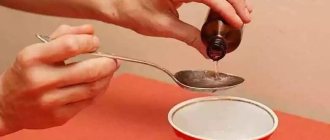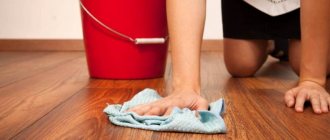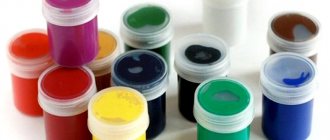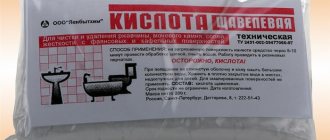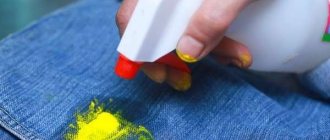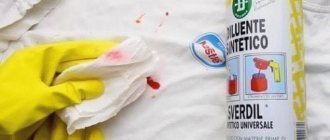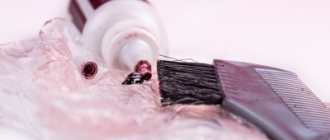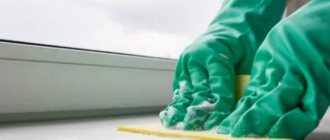Workers painting benches in cities do not always warn citizens not to sit on them. The consequence of such carelessness is paint stains from the painted bench on clothes.
You can wash them with various improvised and special means. But first you need to find out what kind of paint the item was damaged by.
In this article we will tell you how to remove paint from clothes from a painted bench (bench) at home.
Determining Process Complexity
It's easier to clean paint stains from clothes if you know the following:
- type of textile – natural, artificial;
- residence time of the mixture - fresh, old stain;
- type of coloring matter, durability.
Removing paint and varnish products requires experience, chemicals, and personal protective equipment. Dry cleaners that provide textile cleaning services have such materials. The main part of coloring substances can be eliminated at home, avoiding unnecessary expenses.
Mixtures that can be cleaned with improvised means:
- watercolor;
- gouache;
- enamel;
- oil;
- acrylic;
- latex;
- water-based.
What to do if you sit on a painted bench
Who hasn't had this kind of trouble happen to you? We sat down on a bench in the park, and it turned out to be freshly painted. The question arises - how to remove paint from a bench?
It seems easier to throw away a damaged item. But you can still try to wipe off the fresh paint from a painted bench at home.
The choice of product depends on the type of paint the bench was painted with and the type of fabric.
Typically, city benches are painted with one of the following types of paint:
- acrylic;
- oil;
- enamel.
Basic Rules
It is not recommended to treat textiles with chemical solvents on painted surfaces - the active substance will cause the top layer to peel off. The work area should be covered with film, white cotton cloth, and paper.
Acrylic, water-based, and oil paints should be removed from clothing in a well-ventilated area. Most solvents have a pungent odor that is unsafe for health, the inhalation of which leads to unpleasant consequences.
It is recommended to first test chemicals by applying a small amount to an inconspicuous area of the item. After checking, you can begin to treat the area where the mixture came into contact - you should act carefully, cleaning in the middle, avoiding spread. The end of the cleaning procedure should be accompanied by hand and machine washing and thorough drying.
Recommendations and prohibitions
When working with solvents, you must follow the advice and observe the prohibitions:
When processing an item, do not rub the product into it too much;- When cleaning, do not rub the stain from its center to the edges;
- do not wash the item after cleaning with a solvent in too hot water;
- Before using a solvent, test its effect on an inconspicuous area of the item.
Old stains should be soaked in alcohol before cleaning. Cloth with dried dirt can also be softened with butter.
Removing oil paint and enamel
Dyes of this type are quite durable, take a long time to wash, and require double or triple processing. Effective ways to remove fresh oil enamel:
- Lubricate the area with vegetable oil and wipe off with a cotton swab. Re-treat the remaining particles with oil, wash off with detergent after half an hour, securing the result by machine or hand washing.
- A concentrated solution of laundry soap can easily remove a fresh stain. Letting clothes sit for 15 minutes followed by washing will allow you to forget about contamination.
- A paste of baking soda and water, thoroughly rubbed into the stain, will help clean things. After 10 minutes, the textiles are rinsed by hand and thrown into the washing machine.
Attention. Chemicals should be used following safety rules, armed with rubber gloves and a respirator.
There are several ways to remove old paint from clothes:
- Kerosene, refined gasoline, white spirit. Algorithm of action: apply the selected substance, wait 15-20 minutes, remove the residue with laundry soap.
- A stain remover containing oxygen also dissolves dyes. It is enough to apply the liquid, then rinse the dirty item.
- An acetone-free nail polish remover mixed with warm glycerin works effectively.
How to remove paint from jeans using chemicals
Household chemicals can also help remove dye from jeans. First of all, you need to use dishwashing detergent, which is found in every home.
The algorithm of actions is as follows:
- Dish detergent is applied to the stain.
- Using a soft sponge, rub it into the fabric and leave for 24 hours.
- The stained area is thoroughly wiped with a brush.
- Jeans are rinsed well.
Bleach works well with unstable dyes and is suitable for cleaning white pants. The soiled item is soaked in bleach for 30-40 minutes, rinsed and placed in the washing machine. Bleach can be replaced with a solution of hydroperite, but it should be used carefully. You should first test hydroperite on a small piece of similar fabric.
You can remove dried paint from trousers or white jeans using chlorine. First, remove as much of the coloring pigment from the surface as possible with a stationery knife. Then place the item in a bleach solution of 5 liters of water and 1 liter of chlorine. Boil for 30 minutes, stir occasionally. The product is then placed in an automatic washing machine.
Among household detergents, tar soap can also help. It can even remove oil paints, as it perfectly dissolves the fatty substances on which these types of dyes are made. The contaminated area is rubbed with soap, before this it is slightly moistened and left for 2-2.5 hours. Wash jeans in the washing machine.
There are special stain removers on sale today designed for these purposes. They must be used strictly according to the instructions so as not to harm the material of the jeans.
Acrylic, water-based paint
Fresh stains can be easily washed off in warm soapy water. To make the procedure more effective, the dirt should be scrubbed with a stiff brush. Process thoroughly for 15-20 minutes.
Attention. Removing paint stains with stiff brushes is suitable for clothes made of thick fabric. It is recommended to clean natural, delicate textiles using more gentle methods.
A swab moistened with alcohol works well and should be used to wipe the stain until the traces disappear. 2 tablespoons of vinegar and salt dissolved in 2 glasses of water help quickly eliminate any remaining substances. The dried stain is pre-soaked, then the chosen stain removal method is used.
Traditional methods
In some cases, it is not necessary to immediately use aggressive chemicals - you can solve the problem using folk recipes.
Gasoline and alcohol
Gasoline is good for removing stains from oil paints. You need to apply it to a cotton swab and rub the stain all around. After the procedure, the item is washed using powder or gel.
Attention! It is necessary to purchase only refined gasoline, which is sold in hardware stores. A regular product may stain clothing due to impurities in the composition.
Another effective remedy is a combination of laundry soap and alcohol. This recipe can be used against difficult stains on silk and satin. First, the blot is rubbed with soap, then the fabric is rinsed, and the contaminated area is treated with alcohol. Before this, the liquid must be heated in a water bath. After cleaning, you must hand wash the item in hot water.
Alcohol and salt help remove paint from both linen and nylon fabric. The blot needs to be rubbed with heated alcohol on the reverse side, then prepared with a saline solution and washed off any remaining dirt.
Hair fixation spray
Many hair styling products contain weak solvents. They do not harm human health, but help remove stains. Just spray the varnish and throw the item in the wash.
Salt and vinegar
To clean clothes from acrylic dye, you need to prepare a solution from the following ingredients:
- salt – 1 tbsp. l.;
- ammonia - 2 tbsp. l.;
- vinegar - 2 tbsp. l.;
- water – 750 ml.
The components need to be mixed and poured into the blot, leaving the product in the basin overnight. It is recommended to cover it so that the smell of ammonia does not spread to other rooms. The procedure is repeated until the dye completely disappears.
Acetone
Instead of acetone, nail liquid is suitable. First you need to soak a cotton swab in the solution, then start rubbing the stain from the edge to the middle. At the end of the procedure, the item is thrown into the machine.
Attention! Acetone is not used on delicate fabrics.
Turpentine
This product is suitable for removing stains from delicate materials such as silk, satin and wool.
First, apply a little turpentine to a cotton swab to treat the blot on the front and back of the fabric. After 10 minutes, cover the stain with paper towels on both sides and press together with your palms. There will be traces of paint on the paper that were removed by the product.
After this, the dirt is wiped off again with turpentine and left for 60 minutes, then the clothes are washed in the usual way in a machine or by hand.
Glass cleaner
To remove stains from clothes, just spray glass cleaner and rub it in for 2-3 minutes. After this, the dirt is rinsed off and the cleaning is repeated again. Paint stains are not a death sentence for things, since they can be removed with folk remedies and household chemicals. Before the procedure, you must wear protective gloves and follow safety precautions. If the fabric is expensive and requires special care, then it is recommended to take the clothes to the dry cleaner rather than clean them yourself.
Paint can easily get on things during creative activities, during repairs, or by pure accident. There is no point in throwing them away right away, because the stain can be removed. However, before you wipe the paint off your clothes, you should make sure that the products used are harmless.
Latex paint
Contamination with dyes of this type can be removed by treating them with any product containing alcohol. For example, hairspray, acetone, alcohol. You can effectively remove dried colored mixture with adhesive tape - stick it to the contaminated area several times and peel it off.
Reference. Heat treatment of remaining tape leads to reprinting of the adhesive. This can be avoided by carefully removing any remaining adhesive tape.
A contaminated stain that has already dried should be soaked with alcohol, leaving the clothes on for a couple of minutes. The area where the paint hits is sprinkled with salt, then dipped into alcohol again. Carrying out the procedure several times will remove the oldest stains.
Alkyd enamel
White Spirit
Lay the item on a flat surface so that the stain is on top, place an unnecessary rag in several layers under the stained area. Soak a cotton swab or pad in white spirit and treat the stain. When the stain disappears, the item of clothing must be immediately put into the washing machine.
The product cannot be used for items made of delicate fabrics.
Universal methods
How to remove paint from clothes from a bench, fence, or other objects where you can often get dirty? There are several universal methods for removing contaminants. Among them:
- Equal proportions of fatty kefir, vinegar, borax, thoroughly mixed, are applied to the outside and inside of the clothes. After drying, the dirt is cleaned with a toothbrush and washed off.
- Turpentine is an effective grease solvent. A cotton swab moistened with it wipes off almost any type of paint. If necessary, the processing procedure should be repeated.
- 1 tablespoon of salt, 2 each of ammonia and vinegar, mixed thoroughly, applied to the stain, after 10 minutes cleaned with a toothbrush, and washed.
- Light-colored clothes are cleaned by boiling. Chlorine is added to the water, proportion 1:6, heat treatment time 30 minutes.
Effective removal of fresh and old stains of colored mixtures requires careful preparation, knowledge of the matter, the ability to recognize the type of substance, textile, accuracy, and patience. Some stains are not immediately treatable and require longer or additional treatment. In general, removing paint stains is not difficult, following the recommendations given.
Dyes used to paint benches and the nuances of their removal
Street benches are mainly treated with oil paint. This substance is durable. Oil paint leaves corrosive marks on clothes. They may be greasy if greasy paint was used when painting.
When removing such dyes from things, it is necessary to take into account the following features:
Oil paints can only be cleaned with strong solvents. Home remedies like baking soda, vinegar, and salt are less effective against such stains.- Oil paint marks are removed better if they are fresh.
Old stains cannot be treated even with strong solvents. It is recommended to wash oil paint from the item in the first hours after the stain appears.
To more effectively remove traces of greasy paint, it is recommended to pre-heat the stained area with a hot iron through a rag.
Eliminating the consequences of the festival of colors
Special paints that are used to decorate faces and clothes are called “Holi”. It can be difficult to wash them off a jersey T-shirt after the holiday. And if such dyes are washed off from the body simply with soap, then they need to be removed from things in a different way.
Baking soda
“Holi” are powders with bright pigments of plant origin - turmeric, corn, sandalwood and others. How to remove special dye from clothes? To remove such stains, machine wash with a strong stain remover.
Features of cleaning different types of fabrics
Depending on the type of fabric, you need to use different stain removers. All recommendations are presented in the table.
| Fabric type | Removal products |
| Cotton and linen | Washable at 40-95 degrees. Any means are suitable, except those prohibited by the manufacturer of the item. You can dissolve the paint with gasoline, kerosene, white spirit, etc. |
| Synthetics (elastane, polyamide, polyester) | Washing temperature up to 40 degrees. To remove paint, you can use gentle products that do not contain acetone or solvents. You can use lemon juice, glycerin, dishwashing detergent, gasoline, kerosene, and white spirit. |
| Jeans | Vinegar, gasoline, kerosene, tar and laundry soap, acetone, “salt + vinegar + ammonia.” You need to be careful when using any composition on brightly colored jeans. |
| Silk, wool and other delicate fabrics | Hand wash at temperatures up to 30 degrees. Soaking is prohibited. Turpentine and delicate stain removers are suitable for removing paint. |
You will find the basic rules on how and what to remove paint from pants without ruining them in this article.
Rules for removing marks from white, black and colored clothes
When removing dye from white items, the following rules must be observed:
- White items should be soaked separately from colored items.
- Do not try to wipe a stain from a white item with a colored cloth or napkin.
- Items made from natural and synthetic fabrics can be soaked in stain removers and bleaches for a long time.
- You need to rinse the products in warm and then in cool water.
- For white items, you can use products that contain bleaches.
- When removing a stain, the napkin or cotton pad should be changed regularly.
When cleaning colored items, the following rules must be observed:
Black and colored items should be washed separately.- Do not use aggressive stain removers or products containing bleaches to remove paint.
- The maximum soaking time is 1 hour.
- Do not rub the stain too hard with a brush, so as not to provoke the removal of the tissue’s own pigment.
- It is not recommended to wash colored items in water above 40-60 degrees.
Each product has a label on which the rules for washing clothes are indicated. It is located on the inside of the product. This information is required to be read.
Features of acrylic
Working with it, you can highlight the main, basic properties:
- It is a very good paint for professional paintings. When it dries, it turns into plastic (surprising, isn’t it?)
- You can safely use it without fear that acrylic paints will cause allergies.
- You may not know, but a simple table lamp can affect the color shades. This is acrylic!
Stain removers
You can get rid of paint using professional household chemicals. It is important to choose a stain remover that will have strong components in its composition, but will not harm the fabric.
When purchasing, you need to pay attention to the following points:
Purpose of the stain remover . There are products for washing only white or only colored items. Universal stain removers are also available for sale.- Compound. In order for the product to help get rid of paint, it may contain surfactants (active substances that dissolve contaminants), enzymes (amino acids that gently clean fabrics), active oxygen (pushes contaminants to the surface), chlorine (aggressive bleach that is not suitable for washing delicate fabrics). ), alcohol (an active solvent for oil paints).
- Release form . Liquid stain removers are universal, but powder detergents should not be used on delicate items.
General instructions for use with stain removers:
- Remove hard crust from the surface of the fabric. To do this, you need to carefully rub the paint with a knife or blade.
- Apply the substance to the stain. For powder products, the contaminated area is pre-moistened with water.
- Leave for a while (exact instructions are available in the instructions for use for the selected product).
- Wash the item as usual.
If the stain cannot be removed the first time, the cleaning procedure can be repeated.
Top 3 best
You can get rid of paint using the following means:
Udalix Oxi Ultra .
This powder contains enzymes, surfactants and oxygen bleach, which means it can cope with even the most stubborn stains. The product works best at a water temperature of 60 degrees. For soaking, take 3 tablespoons of powder per 2 liters of liquid. Exposure time – 1-3 hours. The cost of a 500 g package is 270 rubles.- Dr. Stain Remover Salt Beckmann .
Salt helps remove stubborn paint stains because it contains a fat solvent and active oxygen. The stain must be wetted with water, sprinkled with powder and moistened again. Leave the product on for 60 minutes or longer, after which the item is washed as usual. The cost of a 100 g package is 130 rubles. - Typhoon Oxi-pro . This stain remover contains active oxygen, which helps remove stubborn stains, but should not be used on delicate fabrics. To soak, you will need to dissolve 1.5 scoops of powder in 1 liter of water. It may take up to 12 hours to remove the stain. Then the item is washed as usual. The cost of a 270 g package is 180 rubles.
Stain removers can be purchased in departments with household chemicals, or ordered online.
How to remove dirt from other surfaces
How to remove paint from clothes becomes clear, but how to get rid of paint if it is not located on textiles? Here are several methods, depending on the type of surface:
- Paint can be removed from plastic using gasoline, kerosene or solvent. How to wipe off paints and varnishes correctly so as not to damage the coating? Plastic surfaces should be rubbed with a small amount of the product and immediately rinsed with water.
- Some people like to dye items without taking off their white sneakers. Naturally, the dye gets on them. Cleaning sneakers is easy, even if they are made of leatherette. In this case, solvent or kerosene is used. You need to wipe the surface with cotton wool soaked in a flammable product. If the leather or fabric base is smeared, then you will have to work hard here.
- The paint and varnish is easily washed off glass and plastic with white spirit. Remove the remaining paint from the glass using a blade (you cannot remove the substance from plastic this way), then wash the traces with a solvent. The surface must be cleaned of solvent; it is better to wash it under water with detergents.
In order for paint to be properly removed from textiles or other surfaces, you need to do painstaking work. We get rid of stains efficiently and effectively using home remedies that can be found in any kitchen, in any medicine cabinet. In the purified version, the site of previous contamination may appear, but very weakly.
Now you know how to remove paint from clothes. Stores sell special solutions and substances that will help get rid of dyes. They are aimed at ensuring that any girl can wipe off paint and varnish from the surface.
Expert advice (2 videos)
All means and methods (25 photos)
How to quickly get rid of dried out?
Important features for removing dried paint:
- If the paint is dry, you need to scrape it a little with a knife or razor to remove the top layer.
- To soften the paint, you can use vegetable oil or butter.
- Compresses with the chosen cleanser help a lot. They are left on the stain for 15-30 minutes.
Read more here.
Removing old stains
It is not always possible to detect a problem right away. And then methods for removing old stains come to the rescue. Turpentine softens old paint well, so you should try it first.
Dishwashing detergent is effective in the fight against dried stains. In its composition you can find substances - fat thinners, which can dissolve traces of paint. The first step is to soak the desired item in a mixture of water and detergent for at least 11 hours. Then the mark will need to be rubbed with the hard side of the sponge.
In order not to throw away an item with a paint stain, you can take it to the studio and sew on an interesting applique to match the clothes.
